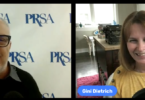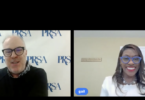Last year, PRSA decided its definition of public relations, last updated in 1982, was in need of refreshing. The decision was based largely upon comments made across various social media platforms that said, well, PRSA’s definition of public relations needs refreshing.
So we embarked on an effort to modernize the definition of public relations that we use on our website and in our materials. Our goal was to create a baseline definition that captures the core essence of what it is public relations professionals do; one that every professional could reference, use and improve upon by adding context specific to what they do, and how they do it.
Because our definition is often used or referenced by others, we invited the profession to tell us what it should say. We asked 12 other professional organizations, from the Arthur W. Page Society and IABC in the United States to CPRS in Canada and CIPR in the UK, to help us. We also wanted to give professionals from around the world a way to take part.
Thus, the idea of using a form containing fields to collect specific types of input from professionals was born at the initial “summit” meeting we held with our organizational partners. Some of the “standard” definitions of marketing and advertising that the group collectively liked contained the following basic elements: they [do what] with/for [whom] to [do what] for [what purpose]. The form was seen as a way to ensure our new definition of public relations would contain these well-liked elements, while also making the data analysis easier.
The “crowd sourcing” effort allowed anyone — PRSA members and non-members alike — to contribute ideas for what the definition should say. That effort generated 294,000 page views of the “Public Relations Defined” website; 927 definitions submitted via the form, comprising 15,688 words; and more than 80 comments, many of which offered “free-form” definitions.
There also was a two-week period for public comment, when we collected reactions to the three draft definitions that resulted from the crowd sourcing. This attracted more than 150 comments offering perspective and feedback on the definitions. We aggregated those comments, as well as third-party blog posts and articles and the comments and reactions posted there, and provided this qualitative data to our organizational partners. After considering this data, PRSA and its partners debated and agreed to three final candidate definitions.
But now that the three final candidate definitions have been put to a vote, they are creating angst, indignation and even a bit of outrage in some quarters of the profession. To be honest, we had a feeling this would happen. Why?
Because our profession is extremely diverse in terms of job titles and responsibilities, organizational settings and approaches. While everyone wants the definition to reflect what it is they do, or to accomplish what it is they want it to accomplish (from elevator speech to cocktail party explanation), that’s just not possible. This is why our goal was to create a definition that expresses the things that bind us all — regardless of the tactics we use, or how or where we use them.
We also set out to craft a definition that would be based upon the profession’s own input. We easily could have ignored the data in search of more lyrical definitions, but then what would have been the point of crowd sourcing, or of choosing not to dictate to others what we thought the definition should be? We believe wholeheartedly that the definitions we’ve put forward accurately reflect the way in which the public relations professionals who participated in this process described what it is they do for a living.
Finally, there’s never been a consensus definition in the profession’s history. This is why we’re still having this conversation today. And why, based on the reaction to our proposed definitions, we’ll still be having this conversation tomorrow. And the next day. And the next.
This blog comment about our candidate definitions seems to sum it up best: “I’m not 100% sure what the answer is, but what I do know is that public relations is too complicated to sum up in one sentence. Especially one that will please everyone.”
The Path Forward
We’ve listened closely to comments such as these. We’ve read the articles, blog posts and Tweets, from the vituperative to the satirical. I’ll admit, some of it has been hard to read, but it has been instructive.
Those who don’t like our definitions want us to start over, but the definitions we put forward are inclusive and true to the research, and even if we were to begin again, we still wouldn’t make everyone happy. For those reasons, we’re going to move ahead with the voting, and we’re going to adopt the winning definition — at least for the time being.
Looking past the rhetoric and reaction, what’s become clear to us is that the process should not stop here. For that reason, PRSA is going to keep the Public Relations Defined blog up after the winning definition is announced.
We’re going to publish the quantitative and qualitative data, including the comments, suggestions and other feedback received outside the submission form, and during the public comment period. With our partners’ permission, we’ll publish the summit notes and the emails they sent with their feedback on the process and the definitions. If you have questions about the data, or the process, or what we were intending to achieve through this process, we’ll answer them.
We’ll also publish and promote guest posts from anyone who has something to say on the subject, from those who have conducted their own research to those who have process suggestions to those who simply feel they have a better definition to offer.
In our perfect vision for this blog, it will become a virtual water cooler, where we can continue to engage professionals on the definition of public relations; it will attract broad interest from individuals from across the spectrum, including traditionalists and non-traditionalists, academics and professionals, agency and corporate, profit and non-profit, domestic and international, critics and supporters alike; and it will advance public relations in a spirit of professional respect, cooperation and empathy.
This is your invitation and your opportunity to come up with something better. Our minds are open. If, through the Public Relations Defined blog, we move closer to a consensus definition of public relations, PRSA will support it.
David C. Rickey is PRSA Secretary and Chair of the Public Relations Defined Task Force.







You seem pretty open minded. And that is encouraging. So, will you reconsider starting over if say 10K PR / Comms folks agree that starting over without the Mad Lib approach is the right thing to do?
It’s encouraging to see the door has been left cracked open. Undoubtedly, Arthur, you know where I stand on the current definitions so I’ll leave it at that. However, in my heart of hearts, I also believe we can, should and must develop a more suitable definition.
Congratulations on taking some of the criticism and allowing it to shape the discussion even further! You can count on a guest post from me.
Wow. “I told you so” almost feels like piling on. http://flackops.blogspot.com/2012/01/future-of-pr-hold-bernays.html
[…] who voted on the candidate definitions, as well as those who voiced their opinions and provided valuable feedback about the process and candidate definitions. We also owe a debt of gratitude to the 12 organizations that partnered […]
My favorite definition of PR comes from PR News in 1961. My recollection is that it said “Public relations is a management function that identifies the goals and objectives of an indivual or organization with the public interest and recommends a program of action to earn understanding and support.” No other definitions that I’ve seen are as comprehensive or concise.
I can’t understand how PRSA could have developed a definition hicht ignores the reality that PR supports the communications needs of individuals and not just organizations.
Jonathan Bernstein
President
Bernstein Crisis Management, Inc.
[…] […]
[…] […]
[…] Great Links: Why modernise the definition of PR? PRSA chair Corbett explains. Public Relations Defined: Our Teachable Moment […]
[…] públicas no convence a todos, por lo que la PRSA sigue abierta a nuevas propuestas desde su blog. Y es que “como la belleza, la definición de relaciones públicas está en el ojo del […]
[…] Public Relations Defined: Our Teachable Moment (Feb. 23, 2012) […]
[…] tener relacionistas y comunicadores contentos con su definición observo que en la página de la PRSA siguen los comentarios y críticas. Por otro lado, Gerard Corbett, consejero delegado de la […]
[…] públicas no convence a todos, por lo que la PRSA sigue abierta a nuevas propuestas desde su blog. Y es que “como la belleza, la definición de relaciones públicas está en el ojo del […]